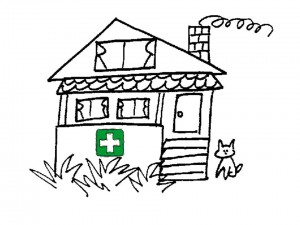 With peoples’ adoption of mobile phones, broadband, and apps for which they pay out-of-pocket, the new person-centered medical home is…the home.
With peoples’ adoption of mobile phones, broadband, and apps for which they pay out-of-pocket, the new person-centered medical home is…the home.
Policy wonks can wax lyrically and econometrically spin models about how to bend the health cost curve. But patients are the most under-utilized resource in the U.S. health system, as Dr. Charles Safran testified to Congress in 2004. In 2010, patients are getting more engaged as they DIY more at-home: photograph development, travel planning, stock trades, and home improvement.
So health care comes home. A column written by Dr. Steven Landers of the Cleveland Clinic, featured in the October 20th 2010 issue of the New England Journal of Medicine, bolsters this concept:
In my Cleveland Clinic practice, I work in my patients’ homes, using a cellular broadband connection to the same electronic record system used by my colleagues in offices and hospitals. I learn practical information about my patients’ medications, management of chronic illnesses, and nutrition and check in on how their caregivers are coping. Patients often see the home visit as a gesture of caring, and many of my older patients express nostalgia for an era when house calls were common. Hundreds of other U.S. physicians are also emphasizing home-based care, many of them now as members of the American Academy of Home Care Physicians.
I’ve been talking about this for some time. This theme is also echoing in Boston this week at the Connected Health Symposium where the Partners Healthcare team is convening a meeting of the brightest minds and learners at the intersection of the technologies and managing chronic health conditions and maintaining wellness.
Earlier this week, the Mobile Health 2010 report from the Pew Internet & American Life Project detailed growing numbers of health citizens adopting the use of cell phones for seeking health information and downloading mobile health apps.
Health Populi’s Hot Points: Most health citizens aren’t yet ready to embrace the full-on Quantified Self lifestyle. However, there’s the rest of us: millions of people trying to manage hypertension; kids with asthma who perennially rush to the ER with uncontrollable wheezing; and, people with difficulty sleeping (an artifact of life in 2010, based on increased prescriptions written for insomnia). Most health citizens have cell phones, whether feature phones or smartphones. Most households in the U.S. have broadband connectivity (although important gaps exist in rural and other segments of the nation-a topic for another blog, here at Health Populi).
Marry $1.8 trillion of spending on chronic health conditions to health citizens’ embrace of technologies, and you’ve got the rationale and home- and mobile-based infrastructure for the medical-home-at-home.
The secret in the adoption sauce? Health engagement, which is in short supply and spotty across the health citizenry. The 2010 Edelman Health Engagement Barometer gauges that about 1 in 5 people are fully engaged in their own health. What to do? It’s complicated, but B.J. Fogg has ideas about putting “hot triggers” in front of people at the right place at the right time via the right media. Then there’s nudging people toward health behaviors through artful design of value-based health benefits. It’s going to take customization, collaboration, and connectivity to realize health engagement for the mass of Us. But the convergence is here for some, coming soon for others, and ultimately, that’s the health reform that can positively impact health outcomes and fiscal fitness.




 Thank you FeedSpot for
Thank you FeedSpot for